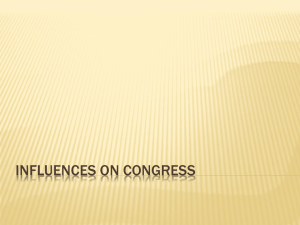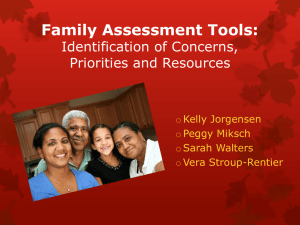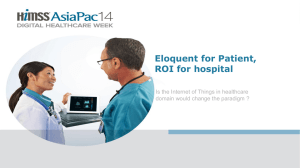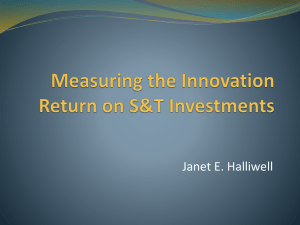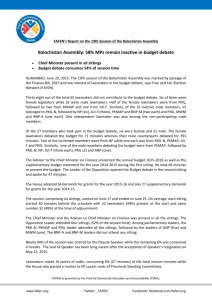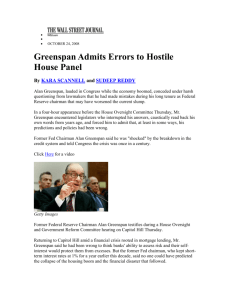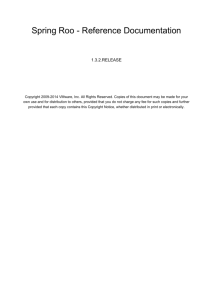PowerPoint Slides - Center for Sharing Public Health Services
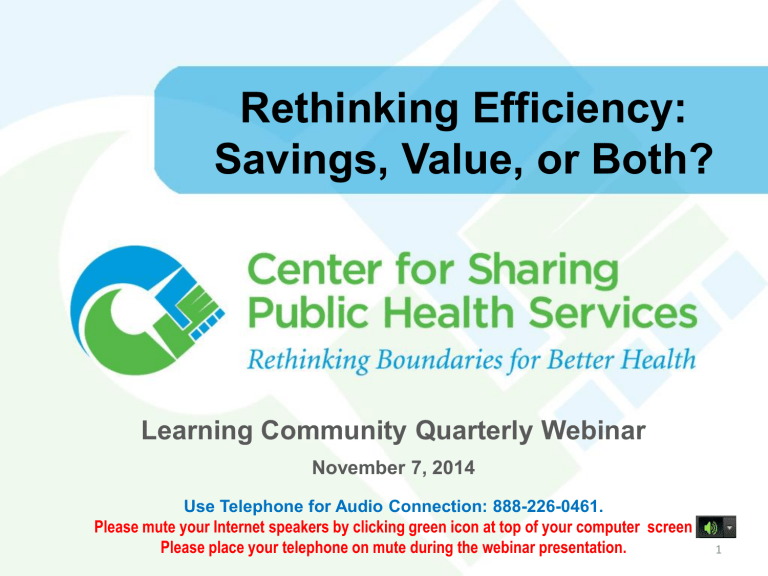
Rethinking Efficiency:
Savings, Value, or Both?
Learning Community Quarterly Webinar
November 7, 2014
Use Telephone for Audio Connection: 888-226-0461.
Please mute your Internet speakers by clicking green icon at top of your computer screen
Please place your telephone on mute during the webinar presentation.
1
Q&A and Discussion
Type into the Q&A and Discussion box at lower right of your computer screen .
2
Learning Objectives
Understand what influences and motivates elected officials and other decision-makers as key audiences for education about public health's value.
Understand how focusing on “return on investment” may
(and often does) undermine efforts to promote the value of public health.
Understand how shifting focus to “return on objective” may better align with the mission of public health and more effectively persuade decision-makers in public and private sectors.
3
Presenter
Emily J. Holubowich, MPP
Senior Vice President, CRD Associates
Executive Director, Coalition for Health Funding
@healthfunding
4
ROI: Right for Public Health?
• What influences lawmakers and other policymakers?
• Does ROI actually undermine efforts to promote public health?
• Are there better ways to communicate value?
5
Federal Spending, FY 2014
Federal Spending, FY 2022
NDD Lowest Level Since 1962
8
9
The Lost Decade
• Levels are too low
– Zero sum gain going forward
– “Robbing Peter to pay Paul”
• Fierce competition for limited resources
– Must do vs. nice to do
• Research vs. public health
– “Hard science” (i.e., basic and clinical) vs. “soft science”
(i.e., population-based research, health services research)
– Infectious disease control vs. chronic disease prevention
10
Cannibalization of Health
The core of public health used to be society’s interest in securing the conditions necessary for human survival— mainly meaning epidemiology and combating communicable diseases. The pity is that all too often the current CDC has diluted its mission and budget by funding political causes that the doctors and troops in
West Africa (and Texas) don’t need. The list extends to anti-bullying, trans fats, prescription opiate abuse, college rape prevention, workplace wellness, “racial and ethnic approaches to community health,” and promoting breast feeding.
—Wall Street Journal, October 9, 2014
11
Cannibalization of Health (cont)
In recent years, the CDC has received significant amounts of funding. Unfortunately, however, many of those funds have been diverted away from programs that can fight infectious diseases, and toward programs far afield from the CDC’s original purpose…
While protecting Americans from infectious diseases received only $180 million from the Prevention Fund, the community transformation grant program received nearly three times as much money—$517.3 million over the same five-year period.
—Gov. Bobby Jindal (R-LA), Politico Magazine, October 12, 2014
12
With Challenges, Come Opportunities
• Lawmakers forced to make tough choices
– What works in public health?
• Simply doing what’s “right” isn’t enough
– Emphasis on evidence, impact
• Community has opportunity to EDUCATE:
– Explain what you do, and why its important
– Share evidence to inform policy decisions
13
Know Your Audience
• Lawmakers at all levels of government, regardless of party:
– Want to make a difference
– Put constituents first
– Drink from a firehose
– Don’t know what they don’t know
14
Know Your Audience (cont)
• Politics often trumps policy
• Ideology, moral beliefs drive decision-making
– Conservatives committed to principle, limited role of government
– Liberals committed to policy, expanded role of government
15
Find Common Ground
• Put yourself in their shoes
– What words, concepts and themes resonate?
• Beware the “backfire effect”
• Secure the psyche
– Don’t directly challenge identity
– Ask what they know
16
Trouble with ROI
• Economists: ROI isn’t appropriate measure for public health
• Savings are often not “in time”
– Projections are meaningless
• Estimates are often in aggregate
– Lawmakers can’t relate
• Other programs aren’t held to same standard
17
“Return on Objective” as Alternative
• Mission of public health is to improve health, not save money
• ROO shows the program accomplished goals that are
– Set before implementation
– Measurable and attainable
– Qualitative or quantitative
• Emphasis on health outcomes
• Efficiency flows from effectiveness
18
ROO Resonates More Than ROI
• Demonstrates impact in community now (not 20 years from now)
• Results don’t necessarily have to be population based
– Power in one
– Data make you credible, stories make you memorable
– See www.cutshurt.org
for examples
• Shows lawmakers, taxpayers they are “smart purchasers” of goods
19
Don’t Overthink It
• Lawmakers aren’t peer reviewers
– Take credit for success
– Anecdotes matter
• Don’t just tell, show
• ROO is “and” not “or”
– Show ROI when possible
– ROO provides context
20
Contact
Emily J. Holubowich, MPP
Senior Vice President
Cavarocchi ∙ Ruscio ∙ Dennis Associates
202.484.1100
eholubowich@dc-crd.com
Follow Me! @healthfunding
21
Q&A and Discussion
Type into the Q&A and Discussion box at lower right of your computer screen .
22
Webinar Evaluation
Please take a few minutes to complete a short evaluation of this webinar by clinking
November 7, 2014 Webinar Evaluation or pasting the following URL into your web browser: https://survey.qualtrics.com/SE/?SID=SV_e5TeYZJHZHECYvz
23

